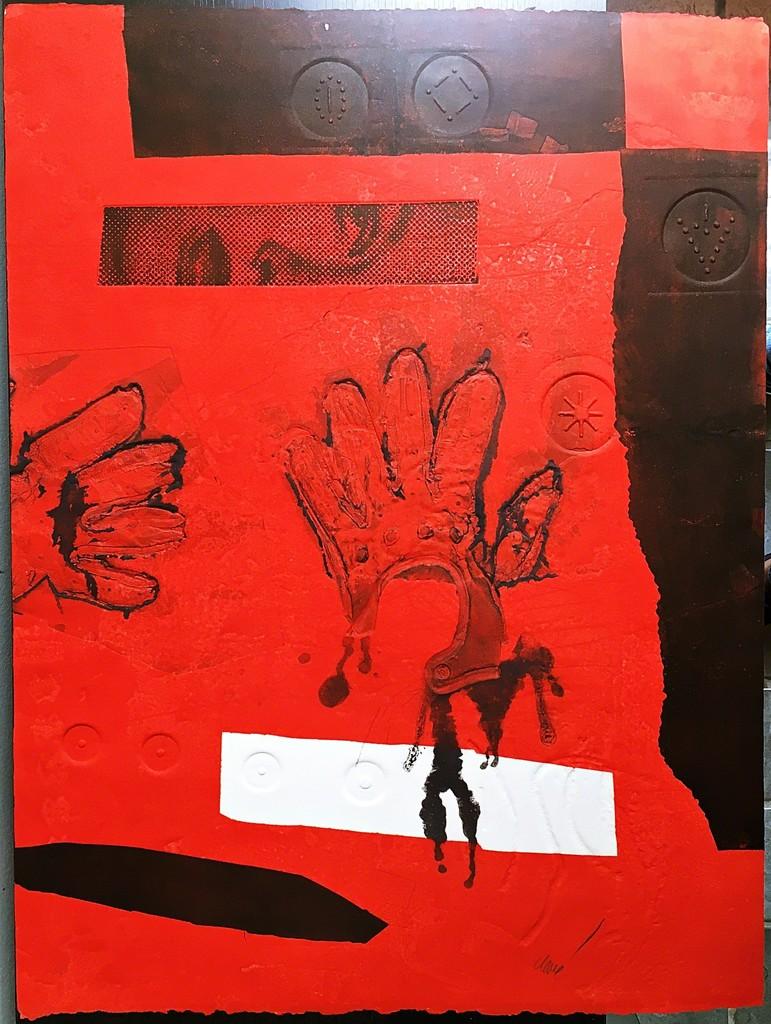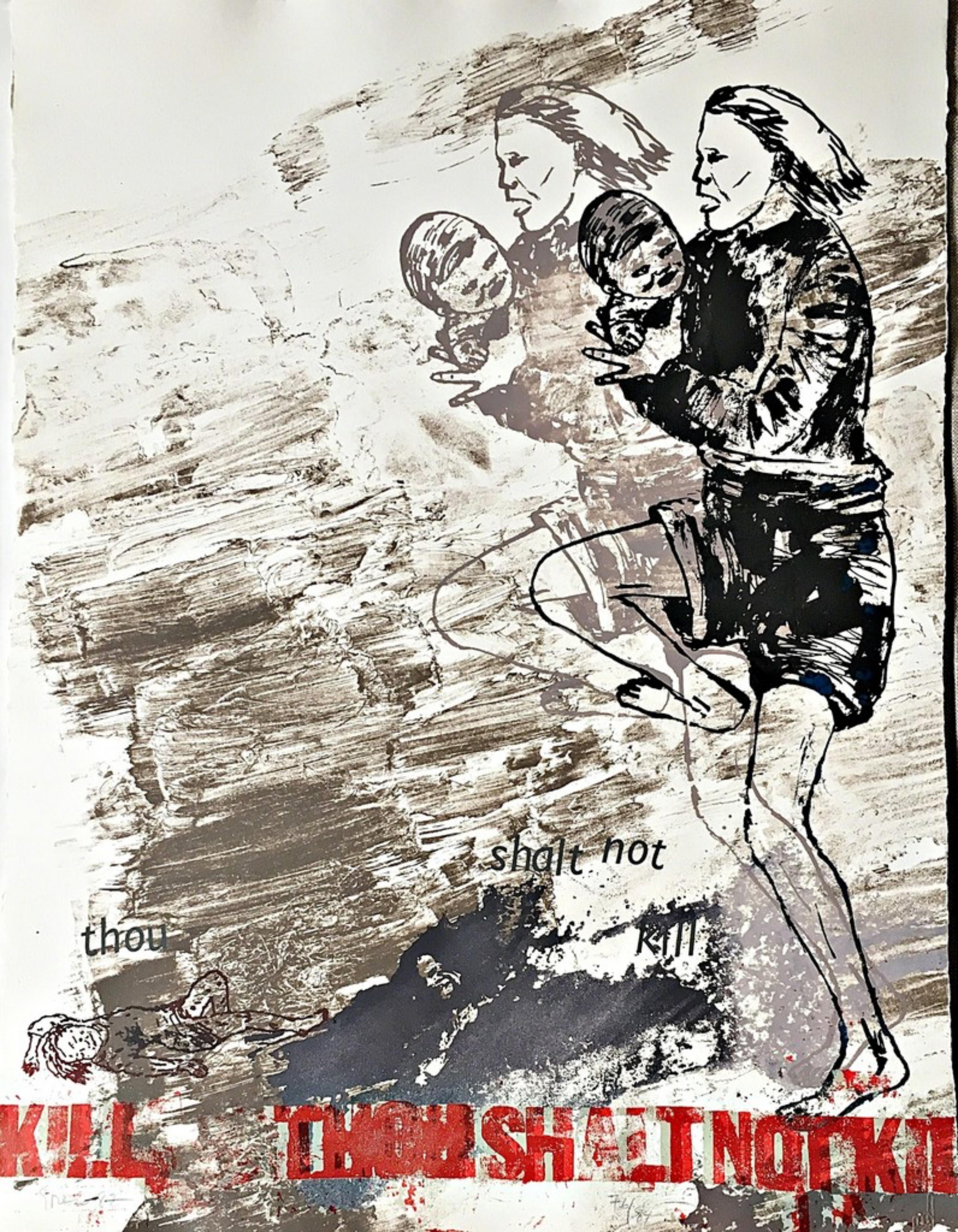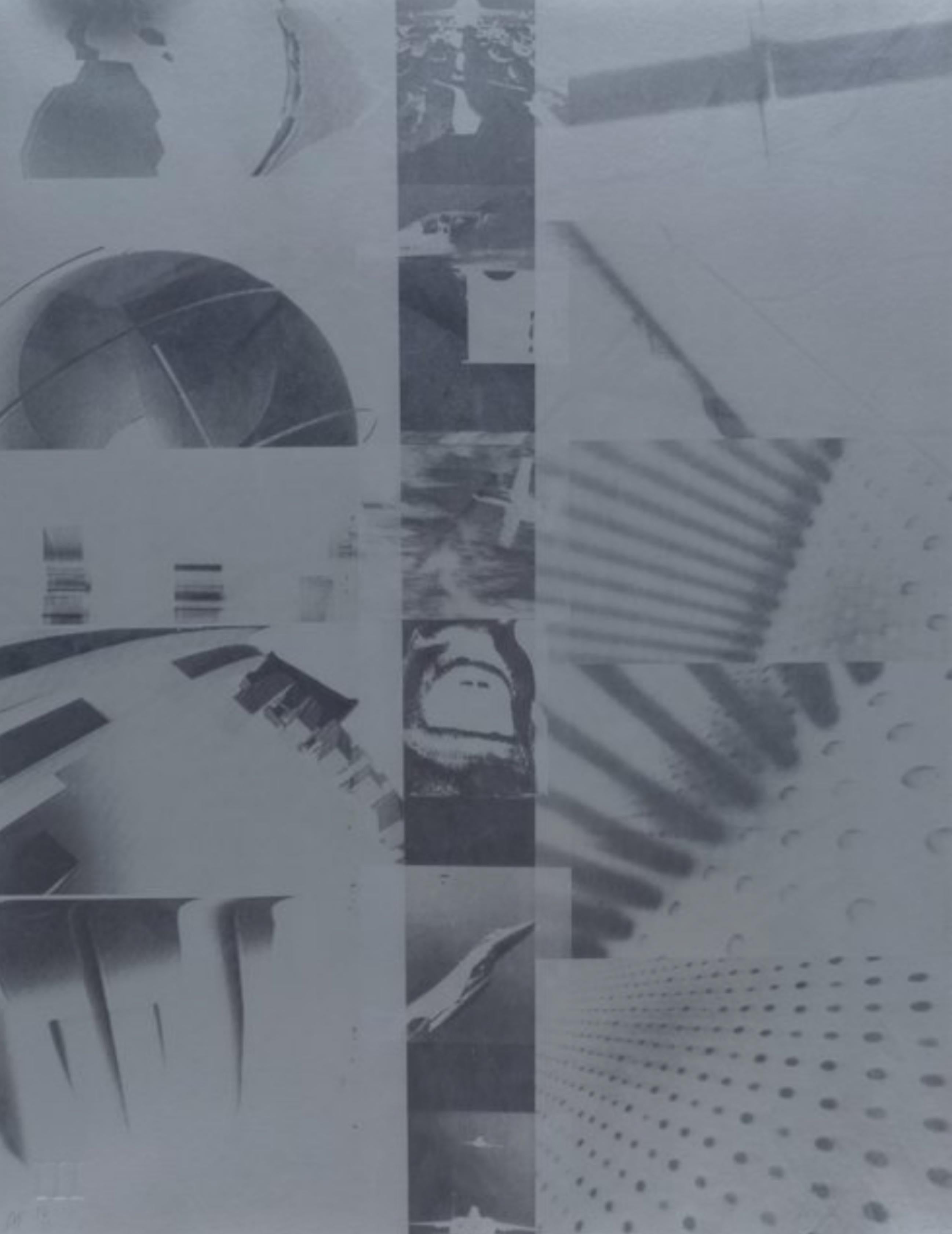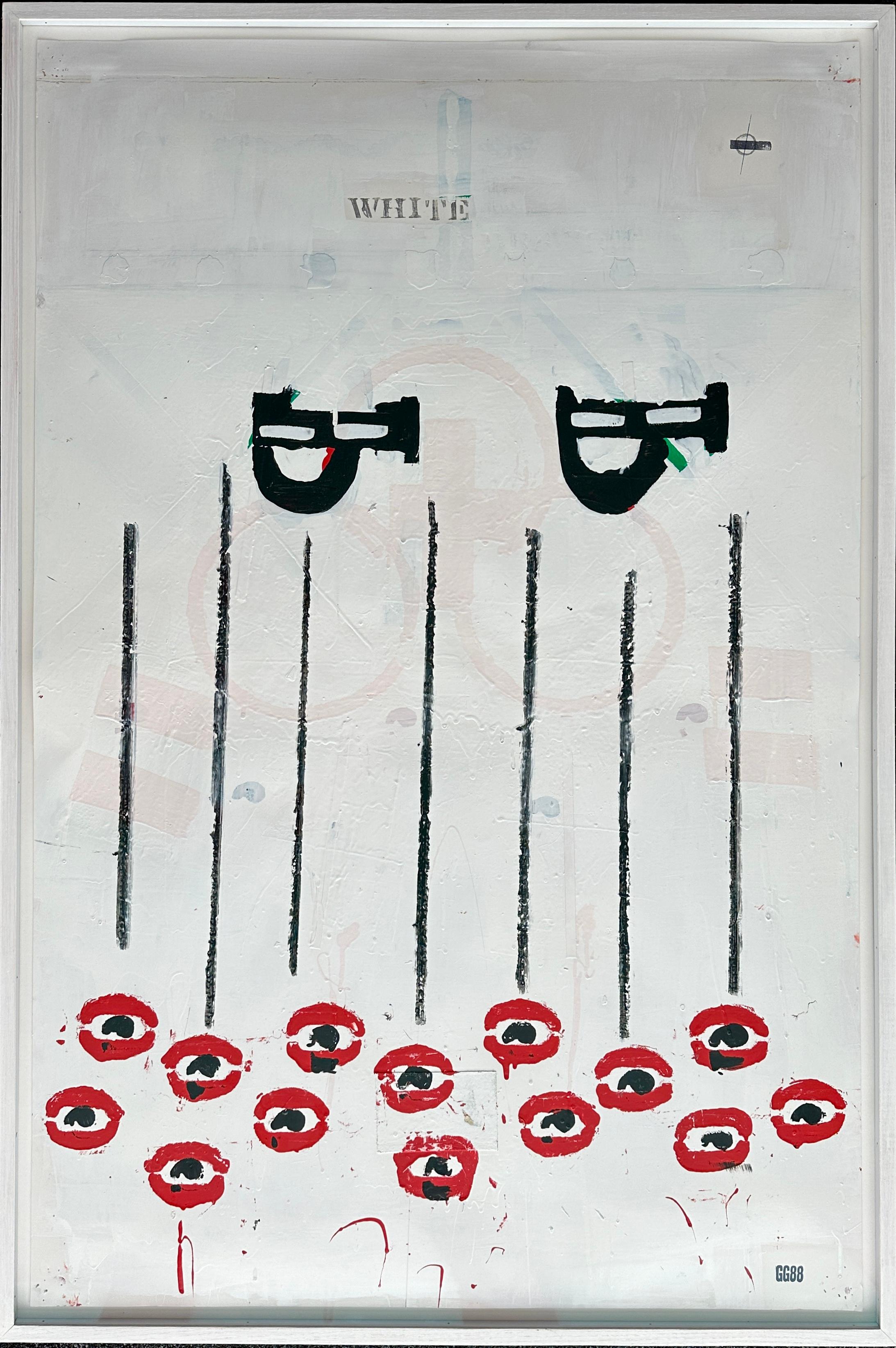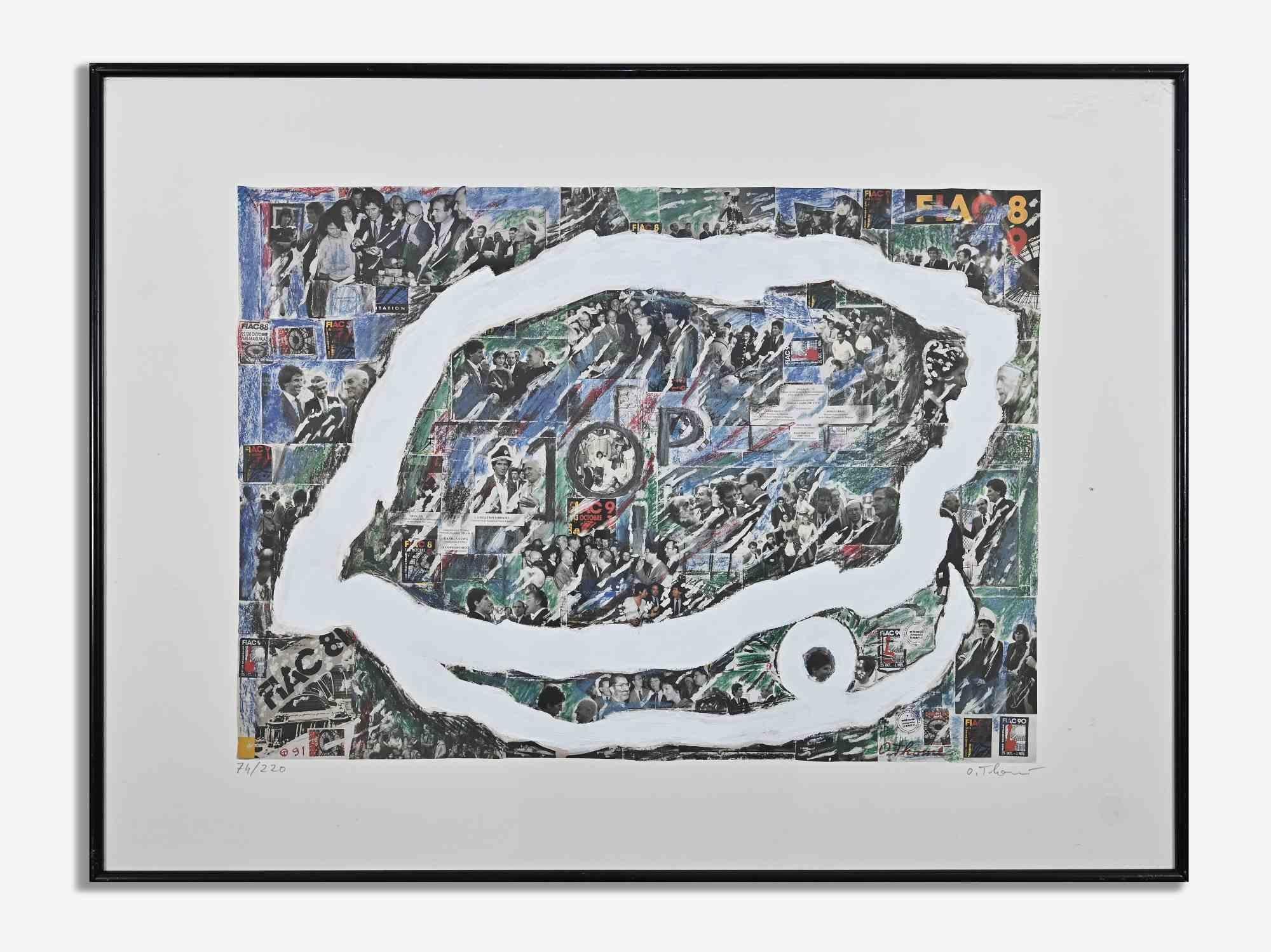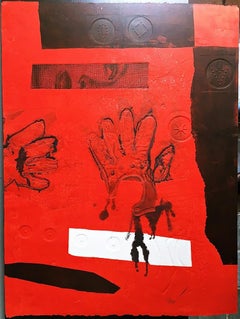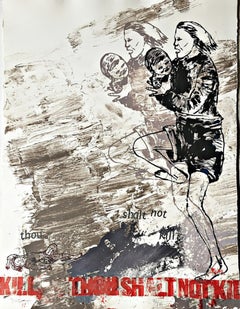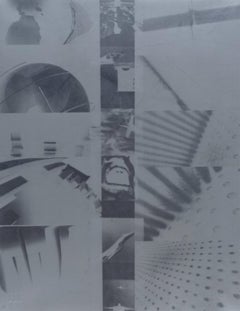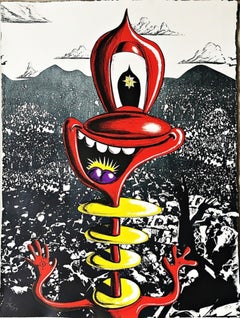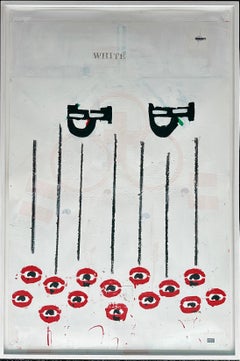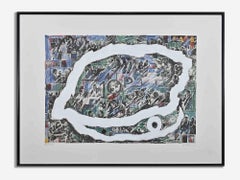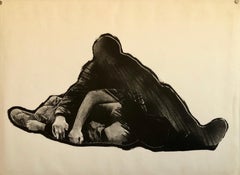Items Similar to Thou Shalt Not Commit Adultery (The 7th Commandment) lithograph + collage Signed
Want more images or videos?
Request additional images or videos from the seller
1 of 10
Vito AcconciThou Shalt Not Commit Adultery (The 7th Commandment) lithograph + collage Signed1987
1987
$2,800
£2,096.79
€2,417.82
CA$3,935.53
A$4,299.55
CHF 2,255.53
MX$52,309.33
NOK 28,059.77
SEK 26,567.87
DKK 18,049.43
About the Item
Vito Acconci
Thou Shalt Not Commit Adultery (The Seventh Commandment), 1987
3 Color Lithograph with Collage with Rives paper
Hand signed and numbered AP 2/15 on the front
Also bears the embossed numerals VII (for the 7th Commandment)
(an Artist's Proof, aside from the regular edition of 84)
Printed by James Miller and Maurice Sanchez at Derriere L'Etoile Studio.
Unframed
"Thou Shalt Not Commit Adultery" is so iconic, that when Acconci died in 2017, the Jewish Museum tweeted out the image of this work - The Seventh Commandment.
This rare Vito Acconci mixed media work on paper was created as part of the 1987 portfolio "The Ten Commandments", in which ten top Jewish American artists were each invited to choose an Old Testament commandment to interpret in contemporary lithographic form. (The "Chosen" artists were, in order of Commandment: Kenny Scharf, Joseph Nechvatal, Gretchen Bender, April Gornik, Robert Kushner, Nancy Spero, Vito Acconci, Jane Dickson, Judy Rifka and Richard Bosman.) Lisa Liebmann, who wrote the introduction to the collection, observed: "...The image has, for most of us, replaced the word..." With respect to the present work she writes, "THE SEVENTH COMMANDMENT against adultery is "in fashion" once again today, though ten years ago conjugal fidelity seemed more like pleasant or happenstance for a happy few, or merely the unsophisticated condition of those lacking opportunity and imagination. Vito Acconci's paean to lust, a state of lapse which he's always believed in, now seems at once poignant - an old fashioned enthusiasm inextricably bound to guilt which is also out of fashion - and unexpectedly radical - propaganda for Eros, currently threatened with ex-communication. .."
VITO ACCONCI BIOGRAPHY
Vito Acconci was born in 1940 in the Bronx, New York. He earned a BA with a major in literature from Holy Cross College in Worcester, Massachusetts, in 1962. Two years later, he completed an MFA in writing at the University of Iowa in Iowa City. After returning to New York, he went on to develop a diverse body of work in poetry, criticism, performance art, sound, film and video, photography, and sculpture.
In the second half of the 1960s, Acconci’s work was centered on poetry and language. In 1969 he began using photography to document various actions, such as jumping, bending, and falling, that he executed in order to understand how his body moved in space. Also in 1969 he performed Following Piece, in which he followed passersby on the street until they entered private spaces. From 1969 to 1974 he continued to explore movement in space, using film and video and adding text panels to his photographs documenting his actions. Some of his performances questioned the nature of gender; other works interjected the private realm into public space. During the 1970 exhibition Information at the Museum of Modern Art in New York, for example, he had his mail forwarded to the museum and went there every day to open it. In Seedbed (1972), he masturbated, he claimed, under a temporary floor at the Sonnabend Gallery in New York, while visitors walked overhead and heard him speaking. In the second half of the 1970s, some of Acconci’s works were comprised solely of his speech on audiotape, and many of his performances forced strangers to interact with one another.
In the late 1970s, Acconci began making sculptures referencing architecture and furniture. From 1980 on, some of his sculptures demanded viewer participation: to complete pieces shaped like simple houses, for example, viewers pulled ropes that erected the four walls. Subsequent works, most installed outdoors, were meant to be sat on or played upon. The scale of Acconci’s sculptures continued to grow, until he was making public art on a grand scale. From the late 1980s, the artist worked with Acconci Studio, located in Brooklyn, New York. This collaborative group, which included designers in addition to Acconci, developed several public artworks and architectural projects annually. On his own and with Acconci Studio, Acconci produced works for several college campuses and for airports in Philadelphia and San Francisco. Personal Island, designed for Zwolle, the Netherlands (1994), and Island in the Mur, for Graz, Austria (2003), float in bodies of water; the latter includes a theater and a playground.
Acconci taught at numerous institutions, among them the California Institute of the Arts in Valencia, Nova Scotia College of Art & Design in Halifax, San Francisco Art Institute, School of the Art Institute of Chicago, School of Visual Arts in New York, University of North Carolina at Chapel Hill, and Yale University in New Haven.
Following his first solo show in 1969, at the Rhode Island School of Design in Providence, Acconci participated in numerous exhibitions. Retrospectives have been organized by the Stedelijk Museum in Amsterdam (1978) and the Museum of Contemporary Art in Chicago (1980). Print retrospectives have been mounted by Landfall Press in New York (1990) and the Gallery of Art at the University of Missouri in Kansas City (1994). Acconci’s achievements have been recognized with fellowships from the National Endowment for the Arts (1976, 1980, 1983, and 1993), John Simon Guggenheim Memorial Foundation (1979), and American Academy in Rome (1986). He also received the International Sculpture Center’s Lifetime Achievement Award (1997) and two New York City Art Commission Awards for Excellence in Design (1999 and 2004). He was a finalist for the Hugo Boss Prize in 2000. Acconci died on April 27, 2017, in New York.
-Courtesy Guggenheim Museum
- Creator:Vito Acconci (1940 - 2017, Italian)
- Creation Year:1987
- Dimensions:Height: 24 in (60.96 cm)Width: 18 in (45.72 cm)
- Medium:
- Movement & Style:
- Period:
- Condition:
- Gallery Location:New York, NY
- Reference Number:1stDibs: LU1745214998742
About the Seller
5.0
Platinum Seller
Premium sellers with a 4.7+ rating and 24-hour response times
Established in 2007
1stDibs seller since 2022
451 sales on 1stDibs
Typical response time: 2 hours
- ShippingRetrieving quote...Shipping from: New York, NY
- Return Policy
Authenticity Guarantee
In the unlikely event there’s an issue with an item’s authenticity, contact us within 1 year for a full refund. DetailsMoney-Back Guarantee
If your item is not as described, is damaged in transit, or does not arrive, contact us within 7 days for a full refund. Details24-Hour Cancellation
You have a 24-hour grace period in which to reconsider your purchase, with no questions asked.Vetted Professional Sellers
Our world-class sellers must adhere to strict standards for service and quality, maintaining the integrity of our listings.Price-Match Guarantee
If you find that a seller listed the same item for a lower price elsewhere, we’ll match it.Trusted Global Delivery
Our best-in-class carrier network provides specialized shipping options worldwide, including custom delivery.More From This Seller
View AllAbstract mixed media lithograph and relief by Spanish artist, Picasso friend S/N
By Antoni Clavé
Located in New York, NY
Antoni Clavé
Untitled, from the Album International 2 Portfolio, 1977
Mixed media: Lithograph in relief
29 1/4 × 19 3/4 inches
Edition 1/50
Signed and number on front
Unframed
This ...
Category
1970s Abstract Abstract Prints
Materials
Mixed Media, Lithograph
Nancy Spero, Thou Shalt Not Kill (The Sixth Commandment), signed/n lithograph
By Nancy Spero
Located in New York, NY
Nancy Spero
Thou Shalt Not Kill (The Sixth Commandment), 1987
from the 10 Commandments Portfolio
9 Color lithograph and letterpress on Dieu Donne handmade paper
24 × 18 inches
Edition AP 2/15
Signed and numbered AP 2/15, aside from the regular edition of 84
Printed by Peter Kruty, Dan Stack and Judy Solodkin
Unframed with deckled edges
This nine color lithograph and letterpress on Dieu Donne handmade paper is a signed, dated and numbered Artist's Proof, numbered AP 2/15, aside from the regular edition of 84. It was created as part of the 1987 portfolio "The Ten Commandments", in which ten top Jewish American artists were each invited to choose an Old Testament commandment to interpret in contemporary lithographic form. The "Chosen" artists were, in order of Commandment: Kenny Scharf, Joseph Nechvatal, Gretchen Bender...
Category
1980s Realist Abstract Prints
Materials
Lithograph
Thou Shalt Not Take the Name of God in Vain (The 3rd Commandment) Signed/N print
Located in New York, NY
Gretchen Bender
Thou Shalt Not Take the Name of God in Vain (The Third Commandment), 1987
2 Color Lithograph and embossment on reflective mylar
Signed and numbered 37 from the limite...
Category
1980s Contemporary Abstract Prints
Materials
Mylar, Lithograph
Thou Shalt Have No Other Gods Before Me, The 1st Commandment Lithograph Signed/N
By Kenny Scharf
Located in New York, NY
Kenny Scharf
Thou Shalt Have No Other Gods Before Me (The First Commandment), 1987
5-Color lithograph on Dieu Donne handmade paper with deckled edges
24 × 18 inches
Hand signed, date...
Category
1980s Pop Art Abstract Prints
Materials
Lithograph
Honor Thy Father and Thy Mother (The Fifth Commandment) Lithograph Signed/N
By Robert Kushner
Located in New York, NY
Robert Kushner
Honor Thy Father and Thy Mother (The Fifth Commandment), 1987
6 Color Lithograph on Dieu Donne handmade paper
24 × 18 inches
Pencil signed and numbered 6/84 in graphite on the front
Unframed with deckled edges
This five color lithograph on Dieu Donne hand made paper with deckled edges is pencil signed, dated and numbered from the limited edition of 84. This 1980s Robert Kushner print was created as part of the 1987 portfolio "The Ten Commandments", in which ten top Jewish American artists were each invited to choose an Old Testament commandment to interpret in contemporary lithographic form. The "Chosen" artists were, in order of Commandment: Kenny Scharf, Joseph Nechvatal, Gretchen Bender, April Gornik, Robert Kushner, Nancy Spero, Vito Acconci, Jane Dickson, Judy Rifka and Richard Bosman. This is the first time the print will have been removed from the original portfolio case. (shown). Lisa Liebmann, who wrote the introduction to the collection, observed: "...The image has, for most of us, replaced the word..." With respect to the present work, she writes, "There is a sweet smell of nostalgia to Robert Kushner's view of the FIFTH COMMANDMENT, to honor one's parents. Kushner's subtly ornate use of colors suffuses his subject with a filagreed texture of warmth. In this gentle icon, the traditional duo - all those Ozzies and Harriets in our hearts and on the airwaves -are frames as if by a bubble bath of affection."
ROBERT KUSHNER BIOGRAPHY
Since participating in the early years of the Pattern and Decoration Movement in the 1970s, Robert Kushner has continued to address controversial issues involving decoration. Kushner draws from a unique range of influences, including Islamic and European textiles, Henri Matisse, Georgia O’Keeffe, Charles Demuth, Pierre Bonnard, Tawaraya Sotatsu, Ito Jakuchu, Qi Baishi, and Wu...
Category
1980s Contemporary Figurative Prints
Materials
Lithograph
Sweet Filthy Cheat (unique signed mixed media painting with artist studio label)
By Billy Al Bengston
Located in New York, NY
Billy Al Bengston
Sweet Filthy Cheat, 2004
Watercolor and acrylic on paper
Signed, dated and titled on the front
Frame included
Unique
This unique work, with it's charmingly sly tit...
Category
Early 2000s Pop Art Abstract Drawings and Watercolors
Materials
Mixed Media, Acrylic, Watercolor, Pencil
You May Also Like
Abstract Composition AI, 1979 - litograph, 86x66 cm, framed
By Arman
Located in Nice, FR
Lithograf, signed lower right, Number:15/150
Dim: 66cm x 86cm Height
Arman (November 17, 1928 – October 22, 2005) was a French-born American artist.[1] Born Armand Fernandez...
Category
Late 20th Century Contemporary Abstract Prints
Materials
Lithograph
O.P. 88 collage on paper by Glenn Goldberg
By Glenn Goldberg
Located in Hudson, NY
O.P. 88 (1988)
Pencil, ink, enamel and collage on paper
46" x 30"
48 ½" x 32 ½" x 2" framed
Stamped "GG88" lower right by artist with his signature stamp.
Provenance: M. Knoedler &...
Category
1980s Abstract Mixed Media
Materials
Enamel
Abstract Composition - Lithograph by Olivier Thomè - 1980s
Located in Roma, IT
Abstract composition is an original contemporary artwork realized by Olivier Thomè in the 1980s.
Mixed colored lithograph on paper.
Hand signed on the lower right margin.
Numbered...
Category
1980s Modern Abstract Prints
Materials
Lithograph
El Herido, 1960's Spanish Avant Garde Political Screenprint Lithograph Signed
By Rafael Canogar
Located in Surfside, FL
The Wounded One (El Herido) from Violence (La Violencia) 1969 signed, dated and titled in pencil
Dimensions: sheet: 22 1/16 x 30 1/16" (56 x 76.4cm)
Rafael Canogar ( Toledo , 1935) is a Spanish painter, one of the leading representatives of abstract art in Spain.
Disciple of Daniel Vazquez Díaz (1948-1953), in his first works he found a way to reach the avant garde and, very soon, to study abstraction deeply.
He initially used a sculpture technique: with his hands he scratched or squeezed the paste that vibrated on flat colored backgrounds. It was a painting in which the initial gesture comes directly from the heart. At this point, Canogar embodied the best of painting material .
In 1957 he founded with other artists the EI Paso group. With artists like Luis Feito, Manolo Millares, Pablo Serrano, Manuel Rivera and Antonio Saura, he begins the Spanish avant-garde movement and continues to do so until 1960. It is influenced by Action painting. They defended, between 1957 and 1960 , an informal aesthetic and the opening of Franco Spain...
Category
1960s Modern Abstract Prints
Materials
Screen
Chakras Gone Wild #5, embossed serigraph monoprint, abstract, biomorphic
By George Goodridge
Located in Jersey City, NJ
Chakras Gone Wild #5, 2016. Hand pulled embossed serigraph monoprint on Arches Platine 310 gram paper. Red, blue, black and white. Non Objective, abstract, unique. Print size is 30" ...
Category
2010s Abstract Geometric Abstract Prints
Materials
Ink, Rag Paper
Untitled No. 2 - Soody Sharifi, Mixed Media Collage, Middle Eastern Artist
By Soody Sharifi
Located in Houston, TX
Soody Sharifi, mixed media collage on paper, Middle Eastern Artist. Framed artwork in brand new condition. Signed by artist on verso.
Category
2010s Contemporary Mixed Media
Materials
Archival Ink, Satin Paper, Inkjet
More Ways To Browse
Luciano Castelli
Milan Lukac
Motherwell Africa Suite
Mourlot Corbusier
Pablo Eduardo
Pepe Tanzi
Peter Max Signed Flowers
Philip Guston Prints
Picasso Affiches
Picasso Chat
Pierre Gaillardot
Quelques Fleurs Pour Des Amis
Rauschenberg Collage
Robert Barry
Robert Fisher
Robert Indiana Two
Robert Motherwell Africa
Robert Motherwell Octavio Paz
